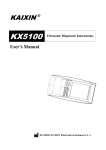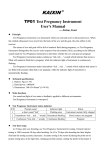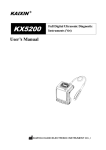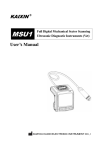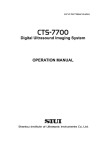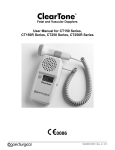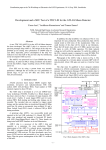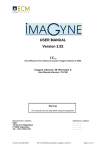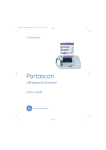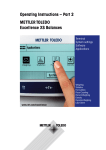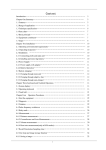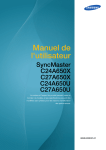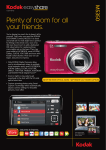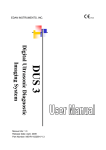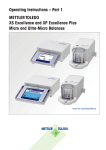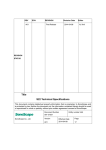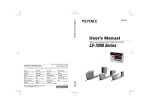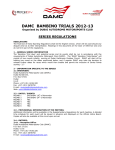Download KAIXIN ® KX5000 Ultrasonic Diagnostic Instruments User`s Manual
Transcript
KAIXIN ® KX5000 Ultrasonic Diagnostic Instruments User’s Manual XUZHOU KAIXIN Electronic Instrument Co., Ltd. Ultrasonic Diagnostic Instruments User’s Manual V1.01 Information for Users Users shall carefully read through this manual and fully understand the text before operating the equipment. This manual shall be placed easy of access for future reference; otherwise it may cause instrument damage or person injury. Intellectual Property Information Xuzhou Kaixin Electronic Instrument Company Ltd. (hereinafter referred to as Kaixin has the copyright of this user’s manual and reserves the right to keep it confidential. This user’s manual shall be used for the sole purpose of operation, maintenance and servicing of Kaixin’s products. This user’s manual and intellectual property right (including copyright) herewith included is property of Kaixin. No persons may use, disclose or allow a third party to obtain by any means any of the information contained herein without prior written consent of Kaixin. No persons may reproduce this user’s manual, in whole or in part, including but not limited to photography, photocopy, reprint or translation into any other language without prior written consent of Kaixin. This is registered trade mark of Kaixin Company. Kaixin is the sole authority for the interpretation of this user’s manual. Kaixin may revise this manual without prior notice. Kaixin may revise its technical process without prior notice. Kaixin may modify specifications of the product without prior notice. Liability and Disclaimer Statement Kaixin does not guarantee the correctness of information contained in this manual. Kaixin bears no responsibility for the use of this user’s manual, including but not limited to responsibilities of implied marketability or merchantability applicable to the product for a particular use. Kaixin shall be responsible for the safety, reliability and proper performance of this equipment on condition that the assembly, extension, readjustment, modification or service of the equipment herewith related is done by technical personnel authorized or approved by Kaixin Electronic Instrument Company Ltd.; The electric equipment is consistent with relevant national standards and the equipment is operated in compliance with the operation guidance. Kaixin does not guarantee the safety, reliability and proper performance of the product in case of the following conditions: Equipment or units of which the equipment is formed are disassembled and reassemble, extended or readjusted without proper authorization; Users fail to properly operate the equipment in accordance with the requirements specified in this user’s manual. Product Information Issue date: June 15, 2011 Version: V1.02 F-1 Ultrasonic Diagnostic Instruments User’s Manual V1.01 Limited Warranty Repair Service 1. Kaixin offers Type B lifetime warranty and charge free repair service from the day of purchasing the equipment: eighteen months for main unit and typical configured probe and six months for other components. 2. Within warranty period, the company will not be responsible for the following situation: 1) Damage or malfunction arising from failing to comply with the instructions of the User’s Manual; 2) Damage or malfunction caused by falling during moving after purchased; 3) Warranty is expired; 4) Damage or malfunction due to human factors; 5) Damage or malfunction caused by disassembling and assembling, alteration and repair without the consent of the company; 6) Instrument losses induced by Force Majeure (like abnormal power supply, fire, flood, lightning strike, earthquake etc.); 7) Damage or malfunction caused by use of unqualified ultrasonic coupling gel; 8) Damage or malfunction caused by use of probe not provided by our company; 3. The company will offer repair service for instrument out of warranty, but additional fees of materials and repair service will be charged. 4. The customer can repair the instrument out of warranty by themselves, and if necessary, the company can provide circuit diagram and components under customers’ request. Return of Goods Follow the procedure below if you need to return the purchased equipment: To obtain the right to return the goods, contact local dealer of Kaixin Company, indicating serial number of main unit, this number is located on the nameplate of main unit. Please mark the product model, the serial number of main unit and reason to return the product. Manufacturer’s Information Xuzhou Kaixin Electronic Instrument Co., Ltd. Kaixin Mansion, C-01, Economic Development Zone, Xuzhou, Jiangsu, China. Zip Code: 221004 Tel: +86-516-87732932 87733758 Fax: +86-516-87732932 87792848 Website: http://www.kxele.com E-mail: [email protected] F-2 Ultrasonic Diagnostic Instruments User’s Manual V1.01 Safety Cautions 1. Warning Symbols and Definitions The following warning symbols are used in this manual to indicate safety level and other important items. Please remember these symbols and understand the meaning as you read this user’s manual. These symbols convey specific meanings as detailed in the table below: Symbols & Words Connotation Indicates an imminent danger that may result in personal death or Danger serious injury if not avoided. Indicates a potential danger that may result in personal injury if not avoided. Indicates a potential danger or unexpected use condition that may result in light injury or property loss or affecting the use if not avoided. Indicates that make sure refer to relevant contents in this manual. Warning Attention 2. Safety Symbols Symbols Meaning Symbols Meaning Type B applied part Up AC Power Keep dry DC Power Fragile Main unit power “OFF” Stacking limit by number Main unit power “ON” Temperature limits Humidity limitation Marking for the separate collection of electrical and electronic equipment Atmospheric pressure limitation 3. Labels Label Description Danger: 1. It may have explosion hazard if used with flammable gas. 2. Operate the probe with care. Read the probe information in the relevant manual for proper probe use. Attention: It is prohibited to pull out and insert the probe frequently. F-3 Ultrasonic Diagnostic Instruments User’s Manual V1.01 Attention: It is prohibited to scratch or squeeze the LCD. Attention: Do not place object on the machine. Do not apply external force on the machine. Close the keyboard before moving the machine. Warning: The device should be used only with external AC/DC adapter provided by manufacturer. Use of other AC/DC adapter may cause damaged to the device or cause fire and electric shock hazards. Lithium Ion Battery Pack KX5000 Rating: DC 12.0V 32Wh Battery pack is limited to use only with KX5000/KX5100 ultrasonic diagnostic instrument. Attention: Battery use should note the precautions. Symbol for the marking of electrical and electronics devices according to Directive 2002/96/EC. The device, accessories and the packaging have to be disposed of waste correctly at the end of the usage. Please follow Local Ordinances or Regulations for disposal. F-4 Ultrasonic Diagnostic Instruments User’s Manual V1.01 Contents Chapter One Intended Application…………………………………………………………1 Chapter Two Technical Specifications……………………………………………………2 Chapter Three Product Outline………………………………………………………………3 3.1 Structure composition of the instrument…………………………………………………3 3.2 Name of parts and components……………………………………………………………3 3.3 Parts of the probe……………………………………………………………………………3 3.4 Function keys description…………………………………………………………………4 Chapter Four System Configuration………………………………………………………5 Chapter Five Operation Condition…………………………………………………………5 Chapter Six System Installation and Check………………………………………………6 6.1 System placement……………………………………………………………………………6 6.2 Probe installation……………………………………………………………………………7 6.2.1 Probe connection…………………………………………………………………………7 6.2.2 Probe disconnection………………………………………………………………………7 6.3 Install/Dismantle the battery……………………………………………………………7 6.4 Connect to video recorder…………………………………………………………………8 6.5 Connect to the power………………………………………………………………………8 6.6 Probe check before and after operation………………………………………………8 6.7 Main unit check before and after operation………………………………………………8 6.7.1 Inspection before start-up ………………………………………………………………8 6.7.2 Inspection after start-up…………………………………………………………………8 6.8 System reset………………………………………………………………………………9 Chapter Seven Function Operation………………………………………………………10 7.1 Startup and Shutdown…………………………………………………………………10 7.2 Probe Conversion………………………………………………………………………10 7.3 Image Size Adjustment ………………………………………………………………10 7.4 System Functions Setting ……………………………………………………………10 7.4.1 Time Setting …………………………………………………………………………… 10 7.4.2 TV Mode Setting………………………………………………………………………10 7.4.3 Energy Saving Setting………………………………………………………………10 7.4.4 Characters Brightness Setting………………………………………………………10 7.4.5 Hospital Name Setting………………………………………………………………10 7.4.6 Key Sound Setting……………………………………………………………………11 7.4.7 Compression Curve Setting…………………………………………………………11 7.4.8 Chinese-English Switch ……………………………………………………………11 7.5 System Formula Setting………………………………………………………………11 7.6 Mode Selection…………………………………………………………………………12 7.6.1 B Mode …………………………………………………………………………………12 7.6.2 B/B Mode ………………………………………………………………………………12 7.6.3 4B Mode…………………………………………………………………………………12 7.6.4 B/M Mode………………………………………………………………………………12 7.6.5 M Mode ………………………………………………………………………………12 7.7 Image Quality Adjustment…………………………………………………………………12 7.7.1 Brightness and Contrast Adjustment…………………………………………………12 7.7.2 Total Gain Adjustment…………………………………………………………………12 7.7.3 Near Field Gain Adjustment…………………………………………………………12 7.7.4 Far Field Gain Adjustment……………………………………………………………12 7.7.5 Dynamic Range Adjustment……………………………………………………………12 7.7.6 Frequency Adjustment (Frequency conversion)……………………………………13 Ultrasonic Diagnostic Instruments User’s Manual V1.01 7.7.7 Focus Adjustment and Control…………………………………………………………13 7.7.8 Frame Correlation Adjustment…………………………………………………………13 7.7.9 Post-process Adjustment………………………………………………………………13 7.7.10 Edge Enhancement Adjustment………………………………………………………13 7.8 Image Control……………………………………………………………………………13 7.8.1 Magnification Selection…………………………………………………………………13 7.8.2 Depth Enhancement and Depth range selection………………………………………13 7.8.3 Local Zoom and Local Additive Color………………………………………………13 7.8.4 Image Left/right Flip……………………………………………………………………13 7.8.5 Image Up/down Flip……………………………………………………………………13 7.8.6 Image Negative…………………………………………………………………………13 7.8.7 Scan Range (Angle/Width Change) ……………………………………………………14 7.8.8 Color Selection…………………………………………………………………………14 7.8.9 Image Freeze/Unfreeze…………………………………………………………………14 7.9 Puncture guide and lithotripsy positioning line………………………………………14 7.10 Body Mark and Probe Mark……………………………………………………………14 7.11 Image storage and recall…………………………………………………………………15 7.11.1 Save the image…………………………………………………………………………15 7.11.2 Open the image…………………………………………………………………………16 7.12 Single image dump and mass images dump…………………………………………17 7.13 Delete the image………………………………………………………………………18 7.14 Image review……………………………………………………………………………18 7.15 Cine loop…………………………………………………………………………………18 7.16 Text Input………………………………………………………………………………19 Chapter Eight General Measurement……………………………………………………20 8.1 Distance Measurement…………………………………………………………………20 8.2 Depth Measurement…………………………………………………………………20 8.3 Circumference/Area/Volume Measurement…………………………………………20 8.4 Slope/Heart rate/Cycle Measurement………………………………………………21 Chapter Nine Obstetric Measurement……………………………………………………22 9.1 Measurement and Calculation items………………………………………………22 9.2 Fetus growth parameter measurement……………………………………………22 9.2.1 Measurement of GA and EDC………………………………………………………22 9.2.1.1 Measurement of BPD, CRL, GS, FL, HL, LV, TTD, APTD, FT, TAD, THD, TCD, OFD 22 9.2.1.2 Measurement of HC and AC……………………………………………………………22 9.2.2 Fetus weight measurement……………………………………………………………23 9.3 Obstetric report…………………………………………………………………………24 9.4 Measurement items………………………………………………………………………24 Chapter Ten Principle of Sound Power…………………………………………………25 Chapter Eleven System Clean and Troubleshooting……………………………………26 11.1 Maintenance by users………………………………………………………………26 11.1.1 System clean, disinfect and sterilize………………………………………………26 11.1.2 Use and maintenance for the charging battery……………………………………29 11.2 Troubleshooting…………………………………………………………………………29 Chapter Twelve System Maintenance……………………………………………………30 Chapter Thirteen Accuracy of Measurement……………………………………………31 Chapter Fourteen Storage and Transportation…………………………………………32 Chapter Fifteen Standard Comp lian ce……………………………………………3 2 Chapter Sixteen Safety Classification………………………………………………32 Chapter Seventeen Guidance and Manufacturer’s Declaration…………………………33 Appendix A Sound Power Output Parameter Disclosure………………………………36 Ultrasonic Diagnostic Instruments Chapter One User’s Manual V1.01 Intended Application KX5000 ultrasonic diagnostic instruments are applicable to abdominal viscera (include trans-vagina, gynecologic and obstetric) and small parts ultrasonic diagnosis. Attention: Although ultrasonic diagnostic does not hurt human body, do consider the scanning stop time and frequency for pregnant woman and fetus on the basis of ALARA principle. Attention: The method below should be followed when the intra-cavity probe is used for gynecology and obstetrics. 1. Explain the importance and necessity to the subject to get the understanding and coordination. 2. Get the bladder calculus, no need to fill the bladder. 3. Smear the coupling gel on the top of the probe then put condom on it, and then put the coupling gel on it again. Then place the probe to different position of the uterine cervix and fornix along pelvis axis slowly. 4. Use of the rotation, tilt, pumping the basic approaches of pelvic structure sagittal, coronal, traverse and other cross-sectional profile scanning. 5. Pay attention to the scanning depth so that the organ of near-filed or the far-filed get into the accumulation area for observing. If the position of organ is higher, the operator can press lower abdomen gently (such as bilanual gynecological examination) by left hand to make it next to probe and get the best showing. 1 Ultrasonic Diagnostic Instruments Chapter Two User’s Manual V1.01 Technical Specifications 2.1 Technical Parameters 1. Gray Scale: 256 2. Monitor: 10.4” LCD 3. Adapter rating: 100-240V~, 50/60Hz, 70VA (model: MW125RA1203F01) 4. Output of Adapter: DC12V 3.0A 5. Main device rating: DC12V 3.0A 6. Main Unit Size: approx. 290×245×50mm3 (L×W×H) 7. Main Unit Weight: approx 2.4kg (excluding accessories) 2.2 Primary Functions 1. Display Mode: B, B/B, B/M, M, 4B. 2. M Speed: 1s, 2s, 3s, 4s, 5s, 6s, 7s, 8s. 3. Magnification: ×0.8, ×1.0, ×1.2, ×1.5, ×1.6, ×2.0, ×2.4, ×3.0. 4. Depth range selection. 5. Depth enhancement/pan function. 6. Local zoom. 7. Adjustment of near field, far field, total gain and dynamic range. 8. Single-point, multi-point focusing. 9. Frequency conversion. 10. Angle/width change. 11. Frame correlation function. 12. Image post-processing. 13. Edge enhancement. 14. Images freeze/unfreeze. 15. Vertical, horizontal flip and B/W conversion. 16. Pseudo color display. 17. Case information, image annotation and auto time display. 18. Body marks. 19. Measurement of distance, depth, circumference, area, volume, slope, heart rate and cycle. 20. OB software package including 15 obstetric tables, automatic calculation of EDC and fetus weight. 21. Puncture guide. 22. Image storage. 23. Cine loop. 24. PAL-NTSC Conversion. 25. Energy saving. 26. Chinese-English Switch. 27. Obstetric report. 2 Ultrasonic Diagnostic Instruments User’s Manual V1.01 Chapter Three Product Outline 3.1 Structure composition of the instrument KX5000 ultrasonic diagnostic instruments are composed of main unit and probe etc. 3.2 Name of parts and components Slide button LCD display Keyboard Charge/Electric quantity indicator Power indicator Video signal port Power switch Trackball USB interface Probe socket DC power input port Fig. KX5000 Main Unit sketch map 3.3 Parts of the probe (Take 3.5MHz convex array probe for example) Name (1) Acoustic lens (2) Cable Fig. Name of 3.5MHz convex array probe parts Function To convert electric signal to ultrasonic signal based on principle of converse piezoelectric effect. The ultrasonic signal, after entering the human body, is reflected as echo wave and converted to electric signal again. The acoustic lens is on the probe surface. Supply ultrasonic coupling gel to the acoustic lens surface when performing ultrasonic diagnosis. To connect the probe to probe connector. 3 Ultrasonic Diagnostic Instruments (3) Probe connector (4) Lock/loosen knob User’s Manual V1.01 To connect the probe to ultrasonic diagnostic system. To lock/loosen the connection of probe to ultrasonic diagnostic system. (5) Fix puncture anchor point Fix the puncture bracket. 3.4 Function keys description Function SN. Real-time mode function SN. Function keys keys Freeze mode function 1 B B mode selection 23 Freeze/Unfreeze 2 BB B/B mode selection 24 Direction keys 3 B B B B 4B mode selection 25 Distance/Depth measurement 4 BM B/M mode selection 26 Measurement scaling 5 M M mode selection 27 Circumference/Area measurement 6 Color conversion 28 Obstetric measurement 7 Local zoom 29 8 Depth enhancement and depth range selection 30 Setup 9 Puncture guide 31 Enter key confirm 10 Scan direction conversion Single image dump Switch U disk and Local 32 Text input 11 Image up/down flip 33 Delete 12 Negative 34 Quit 13 M speed conversion 35 Capital and small letter conversion 14 Angle/width change 36 Shift key Clear Clear screen 15 IP Post-process 37 Space key 16 IE Edge enhancement 38 Total gain adjustment 17 Magnification conversion 39 Near field gain adjustment 18 Focus mode selection 40 Far field gain adjustment 19 Frame correlation conversion Mass images dump 41 Dynamic range adjustment 20 Frequency adjustment (Frequency conversion) 42 21 Body Mark Probe conversion 43 22 Cine loop 44 / Character/Change ellipse minor axis key Character/Obstetric report 4 Ultrasonic Diagnostic Instruments User’s Manual V1.01 Chapter Four 4.1 Standard Configuration 1. Main unit 2. 3.5MHz convex array probe 3. Power adapter 4. Internal battery System Configuration 1 unit 1 PC 1 PC 2 PCS 4.2 Optional parts 1. 5.0 MHz micro-convex probe 3. 7.5 MHz high frequency linear array probe Chapter Five 2. 6.5 MHz intra-cavity probe, 4. Video recorder P93W-S Operation Condition 5.1 Power Supply Adapter rating: 100-240V~, 50/60Hz, 70VA Adapter model: MW125RA1203F01 Output of Adapter: DC12V 3.0A Main device rating: DC12V 3.0A 5.2 Operation Environment Ambient temperature: 10℃-40℃; Relative humidity: 30%-75% (without condensation); Atmospheric pressure: 700hPa-1060hPa. 5.3 Storage and Transport Ambient temperature: -20℃-55℃; Relative humidity: 30%-93% (without condensation); Atmospheric pressure: 700hPa-1060hPa. Attention: The mains voltage varies with different countries or regions. Warning: Avoid using this equipment with high frequency operational equipment, or danger may occur. Danger: Do not use this equipment where flammable gas (such as anesthetic gas, oxygen or hydrogen) or flammable liquid (such as alcohol) are present. Failure to do so may result in explosion. Attention: System should be avoided using in following environments: 1. Splash 3. Direct sunlight 5. Strong shock 7. Chemical medicines 9. Poisonous gas 11. Rain 13. Thunderstorm weather 15. Radiation (e.g., x-ray, CT) 2. No ventilation 4. Dramatic temperature change 6.Close to heat source 8. Dust 10. Corrosive gas 12. Moist 14.Strong electromagnetic field (e.g. MRI) 16.Defibrillators or short wave therapy equipment 5 Ultrasonic Diagnostic Instruments Chapter Six User’s Manual V1.01 System Installation and Check Warning: 1. Do not connect the three-core power supply cord to unprotected two-core socket, or electric shock may occur. 2. If breakers and fuse of the mains power socket are identical to those of this system, and they are used to control the current for equipment like life support system, the system shall not be connected to such power supply socket as it may cause breaker or fuse to trip and cut off the power supply to the entire premise in case of malfunction or over current with this ultrasonic system. 3. All plugs of instruments of this system shall be connected into the power socket with protectively earth on the wall and the socket must meet the requirement of power rating of instrument. Multiple portable socket-outlets can not be used for the system. 4. Equipment that connects the signal input part or signal output part must only connect the accessories authorized in this manual, and connect the equipment that complies with IEC 60601-1 standard. When the instrument connects with more than 3 sets of equipment, it may cause the danger of the leakage current accumulation. 5. When this system is installed or used in the patient environment, try to avoid the patient touching the system. If system is with some unknown defects, it may cause danger of electric shock. Warning: 1. When instrument works abnormally, do stop working, turn off the power and check the reason, then contacts the KAIXIN Company about it. 2. Turn off power and pull out of the plug from socket after each ultrasonic diagnostic operation. 3. It is forbidden to drag and press the power and probe cables emphatically; regularly inspect whether there is pull-apart and bareness, if there is the phenomena like this, turn off power supply immediately and change it for new one. 4. It is forbidden to load and unload the probe or move the instrument in galvanic to avoid danger of safety. 5. Pull out of the plug from socket after operation in thunderstorm weather to avoid the instrument being damaged by lightening. 6. If the temperature changes greatly in short time will cause vapor recovery inside of instrument, the case may damage the instrument. 7. The instrument is switched completely only by disconnecting the power supply from the wall socket. 6.1 System placement Please carefully read through and fully understand the safety cautions before moving and placing the system. 1. Unpack the instrument case and check the goods for its completeness according to the packing list furnished. 2. Place the machine on a stable and leveled position. 3. Leave adequate space of 20 centimeters as minimum from rear, left and right side of the machine. Attention: Adequate space from rear, left and right side of the machine shall be reserved, or the machine may malfunction under excessive heat inside the enclosure. 6 Ultrasonic Diagnostic Instruments User’s Manual V1.01 6.2 Probe installation Warning: 1. The Kaixin ultrasonic probe shall be connected to the dedicated Kaixin ultrasonic system only. Select proper probe model according to the relevant instructions of ultrasonic diagnostic system. 2. Check the ultrasonic probe and connecting cable after diagnostic operation. Use of defective probe may cause electric shock. 3. Do not knock or bump the probe, or it may be damaged and cause electric shock. 4. Unauthorized disassembly of the probe shall be prohibited as it may cause electric shock hazard. Attention: 1. Turn off the ultrasonic system before disconnecting the probe. Disconnecting the probe with system power on may damage the system or probe. 2. Before disconnecting the probe, place the cable and probe on a stable and leveled position so that the probe may not be damaged or injury person by unexpected fall. 3. Freeze the instrument when instrument is start-up without operation to increase of service life of probe. 4. Repeat available machine time should be more than 5 minutes to avoid turn on/off power supply in short time. 6.2.1 Probe connection Warning: Make sure that the probe, connecting cable and connector are in normal condition (free of cracks or drop).Use of defective probe may cause electric shock. 1. Insert the probe connector into the probe socket at the back of the main unit. Note the direction of D-head. 2. Rotate the two probe locking knobs clockwise and lock them. 6.2.2 Probe disconnection First turn off the system, and then rotate the locking knobs counterclockwise, pull out the probe connector vertically. 6.3 Install/Dismantle the battery 1. Install battery Gently push the battery box into the main unit and then screw the fasten bolts. 2. Dismantle battery Remove the fasten bolts as shown in Fig. Clasp the battery box with finger and withdraw it gently. Fasten bolts Fig. Install, dismantle the battery 7 Ultrasonic Diagnostic Instruments User’s Manual V1.01 6.4 Connect to video recorder 1. Shutdown the system, connect the equipotential terminal( )of the video recorder to the earthing. 2. Connect the signal connection line to video recorder and the other end to the video output interface on the right of the main unit. 3. Insert the power plug (jack) of the video recorder to its power input socket, the other end to the power supply socket. 6.5 Connect to the power 1. Connect to the power adapter Insert the output plug of adapter into DC power input port, which is on the right of main unit. 2. Connect to the main power supply Insert the power plug (jack) furnished with the machine into power input socket of the power adapter, the other end to the mains socket-outlet. The instrument uses three-core power supply. It connects with the protective earth line when power plug inserts into its socket. Warning: 1. Adapter has no switch. The isolation of the system with the MAINS used to unplug the adapter as the intended isolation means. 2. The equipment should be used only with adapter provided by Kaixin Company. 3. To avoid damaging power adapter or harming people by unexpected fallen, make sure the power adapter is placed on the leveled desk. 6.6 Probe check before and after operation Before and after ultrasonic diagnosis to check if there are any exceptionally on the surface of the probe or cable jacket, such as peeling, cracks, bulge, or if the acoustic lens is reliable, disinfected or cleaned. 6.7 Main unit check before and after operation 6.7.1 Inspection before start-up Check the following items before starting the machine: 1. The temperature, humidity and atmospheric pressure shall meet the requirements of operation condition. 2. No condensation occurs. 3. No distortion, damage or contamination on system and peripheral. Clean the parts as specified in relevant sections, if the contaminant is present. 4. Check the panel, LCD and enclosure to ensure they are in good working condition and free of abnormity (such as cracks and loosened screws). 5. No damage on power cable, and hard up on its connection. 6. Check probe and its cable to ensure they are free of abnormity (such as scuffing, drop-off or contamination). If the contaminant is present, clean, disinfect the contaminated objects as specified in relevant sections. 7. No barriers around the intake of equipment. 8. See to it that probe has been cleaned, disinfected and sterilized; else dispose it as specified in relevant sections. 9. Check all the ports of the machine for possible damage or blockage. 10. Clean the field and environment. 6.7.2 Inspection after start-up Check the following items after starting the machine: 8 Ultrasonic Diagnostic Instruments User’s Manual V1.01 1. No abnormal voice, strange smell and overheating appear. 2. Check the machine to ensure a normal start-up: The power indicator is on and startup picture is shown on the screen. The machine will be then automatically set in B mode. 3. Check the ultrasonic lens is abnormal heat or not when the probe is in use. This can be done by hand touching the probe to feel the temperature of the lens. 4. Check image to ensure trouble-free display (no excessive noise or flickering). 5. Check the panel to ensure normal operation condition. 6. Check the instrument to ensure that the phenomenon of high local temperature will not appear. Attention: If the overheat ultrasonic lens is placed on the patient’s skin, heat injury may occur. Attention: Thoroughly clean the coupling gel on the probe surface each time after ultrasonic operation, or the coupling gel may become hardened on the acoustic lens of the probe, deteriorating quality of image. 6.8 System reset In case of abnormal screen display or system operation, try to restart the system by turning on/off the main unit power. 9 Ultrasonic Diagnostic Instruments Chapter Seven User’s Manual V1.01 Function Operation 7.1 Startup and Shutdown Toggle the power switch of main unit towards , instrument starts up; toggle the power switch towards , instrument shuts down. 7.2 Probe Conversion In real-time mode, press key, can realize probe conversion. 7.3 Image Size Adjustment 1. Press key to enter setting interface; 2. Press key to realize the image size conversion between the normal and full-screen status; 3. Press key to quit setting interface. Note: When display full-screen, no color output. 7.4 System Functions Setting 7.4.1 Time Setting 1. Press key to enter setting interface; 2. Press direction key to select “Minutes, Hours, Day, Month and Year”; 3. When setting minutes, hours, day, month and year, press direction key to increase value or press direction key to decrease value; 4. Press key, press key again to confirm the time setting and quit setting interface; 5. Press key to give up the time setting and quit setting interface. 7.4.2 TV Mode Setting 1. Press key to enter setting interface; 2. Press direction key to move symbol “<” to point to “TV mode”; 3. Press direction key to realize TV mode conversion between PAL and NTSC; 4. Press key to quit setting interface. 7.4.3 Energy Saving Setting 1. Press key to enter setting interface; 2. Press direction key to move symbol “<” to point to “Sleep”; 3. Press direction key to select energy saving time or energy saving close between 1~99 minutes; 4. Press key to quit setting interface. If operation of trackball or any other key is not activated for a period specified by this energy saving setup, the system will automatically enter the energy saving status. Press any key or operate the trackball to bring the system back to normal operation status. 7.4.4 Characters Brightness Setting 1. Press key to enter setting interface; 2. Press direction key to move symbol “<” to point to “Font Bright”; 3. Press direction key to select characters brightness among 160, 192, 224 and 255; 4. Press key to quit setting interface. 7.4.5 Hospital Name Setting 1. Press key to enter setting interface; 2. Press direction key to move symbol “<” to point to “Hospital”; 3. Press direction key to move cursor; 4. Press characters key to input; if error occurs during the character input, press key to delete the characters or press direction key to move the cursor to the wrong characters to retype again; 10 Ultrasonic Diagnostic Instruments User’s Manual V1.01 5. Press key twice to confirm and quit setting interface. 7.4.6 Key Sound Setting 1. Press key to enter setting interface; 2. Press direction key to move symbol “<” to point to “Key Sound”; 3. Press direction key to select between “On” and “Off”; 4. Press key to quit setting interface. 7.4.7 Compression Curve Setting 1. Press key to enter setting interface; 2. Press direction key to move symbol “<” to point to “Compression Curve”; 3. Press direction key to select compression curve among “00 – 07”; 4. Press key to quit setting interface. Note: If use 3.5MHz probe, it is recommended to choose 05 or 06; if use 5.0MHz probe, recommend choose 03 or 04; if use 7.5MHz probe, recommend choose 00 or 01; if use 6.5MHz probe, recommend choose 01 or 02. 7.4.8 Chinese-English Switch 1. Press key to enter setting interface; 2. Press key to switch between Chinese and English; 3. Press key to quit setting interface. 7.5 System Formula Setting 1. Press key to enter setting interface; 2. Press key and then press direction key to move symbol “<” to point to the desired formula item; 3. Press direction key to select the desired formula; 4. Press key, symbol points to “ TIMESET MENU”; press key to quit setting interface. Formula preset table Preset items Options Preset items Options Preset items Options ASUM China ASUM Hadlock Hansmann China Hansmann GS Hellman Hadlock AC Jeanty Rempen Hansmann Merz Tokyo Jeanty Shinozuka China Kurtz BPD Hadlock Merz Mercer Hansmann Osaka FT Paris Jeanty Paris Campell Merz FL Rempen German Osaka Shinozuka Hadlock1 Paris Tokyo Hadlock2 Shinozuka ASUM Hadlock3 Tokyo China Hadlock4 Jeanty Hadlock Hansmann HL Merz Hansmann Merz1 Osaka EFW Jeanty Merz2 Eriksen Nelson CRL Osaka Hansmann TAD Osaka Shepard Paris Paris Tokyo Rempen Hadlock Robinson Hansmann HC Shinozuka Jeanty Tokyo Merz Text 11 Ultrasonic Diagnostic Instruments User’s Manual V1.01 7.6 Mode Selection 7.6.1 B Mode B Mode is the basic operation mode after startup and a single-framed B mode image is B B displayed. Press B B or B B or B M or M key to exit B mode. Press B key to switch single-framed B mode image. 7.6.2 B/B Mode 1. In real-time mode, press B B key to enter B/B mode; 2. B/B image switch. Press B B key to switch left/right image display; B B 3. In real-time mode, press B or B B or B M or M key to exit B/B mode. 7.6.3 4B Mode B B 1. In real-time mode, press B B key to enter 4B mode. B B 2. 4B image switch. Press B B key to switch display among four images; the selected image is activated and the other three are frozen. 3. In real-time mode, press B or B B or B M or M key to exit 4B mode. 7.6.4 B/M Mode 1. In real-time mode, press B M key to enter B/M mode. 2. Change of scan mode. Press B M key to change the M ultra-scan mode. 3. Move sample line. Press direction key to move sample line. B B M 4. In real-time mode, press B or B B or B B or key to exit B/M mode. 7.6.5 M Mode 1. In real-time mode, press M key to enter M mode. 2. Change of M-scan mode: Press M key to change the M ultra-scan mode. 3. Change of M speed: Press key to select the eight kinds of scan speed. B B 4. In real-time mode, press B or B B or B B or B M key to exit M mode. 7.7 Image Quality Adjustment 7.7.1 Brightness and Contrast Adjustment In the startup default status, the adjustment bars of brightness and contrast will be displayed on the screen by pressing direction key , adjust them according to actual need. Press direction key to increase brightness and contrast, direction key to decrease them; press direction keys to select brightness or contrast adjustment. Press key to quit adjustment status. Note: If direction key cannot be adjusted when adjust brightness in normal operation mode, must be exit current operating condition of direction keys. 7.7.2 Total Gain Adjustment In real-time mode, press key, press key to increase image total gain and reduce image total gain so as to control the total gain of the entire image. 7.7.3 Near Field Gain Adjustment In real-time mode, press key, press key to increase near field gain and reduce near field gain so as to control the gain in near field region. 7.7.4 Far Field Gain Adjustment In real-time mode, press key, press key to increase far field gain and reduce far field gain so as to control the gain in far field region. 7.7.5 Dynamic Range Adjustment key to key to key to In real-time mode, press key, press key to increase the value of dynamic range and key to reduce the value of dynamic range so as to control the dynamic range of the entire image. 12 Ultrasonic Diagnostic Instruments User’s Manual V1.01 7.7.6 Frequency Adjustment (Frequency conversion) In real-time mode, press key to realize frequency conversion. The frequency value is displayed at bottom right of the display place. 7.7.7 Focus Adjustment and Control In real-time mode and in B, B/B or 4B mode, press key to choose from the four focus modes of stage 1(Full process dynamic focus), 2, 3 and 4. Focus is intelligent in the status of stage 2, 3 or 4, the focal position and focal length can not be changed at this time. In real-time mode and in B, B/B, B/M, 4B or M mode, press direction key to move the focus up and down. Note: In B/M or M mode, only allowed choosing single focus mode. 7.7.8 Frame Correlation Adjustment In real-time mode, press key to realize the switching among four kinds of frames correlation. 7.7.9 Post-process Adjustment In real-time mode, press IP key to obtain four kinds of corrected images. System default is 2. 7.7.10 Edge Enhancement Adjustment In real-time mode, press IE key to gain four kinds of sharpened image. System default is 0. 7.8 Image Control 7.8.1 Magnification Selection In real-time mode, press key to choose eight kinds of magnifications. 7.8.2 Depth Enhancement and Depth Range Selection In real-time mode, press key, “ ”appears in the center of the screen. Press direction key or operate trackball to move image up/down or left/right so as to observe the images of different depth and width. Press key to quit depth enhancement/pan status. Note: When the selected depth of the image is greater than the showed depth, image can be moved up and down. In real-time mode, press key, depth range selection 1) 17cm 2)18cm 3)19cm 4)20cm 5)21cm 6)22cm 7)23cm 8)24cm are displayed at the bottom of the screen. Press 3 2 4 7 8 5 6 1 key to select corresponding depth at the bottom of the screen, press key to quit depth range selection. Note: There is no depth range selection function when main unit matching probe which its nominal frequency greater than or equal to 6.5MHz. 7.8.3 Local Zoom and Local Additive Color In B mode, press key, a box appears. Press direction key or operate trackball to move the box to place to be enlarged and the selected image to be enlarged. Press key again to quit local zoom status. In the color display, the selected image which by above mentioned operation will be enlarged and added color. 7.8.4 Image Left/right Flip In real-time mode and in B, B/B, 4B or B/M mode, press key to realize image horizontal flip. The image horizontal flip is the change of probe scanning direction. The probe scanning direction is indicated by the arrow on the upper left area of the image. 7.8.5 Image Up/down Flip In real-time mode, press 7.8.6 Image Negative In real-time mode, press key to realize image vertical flip. key to realize negative function. 13 Ultrasonic Diagnostic Instruments User’s Manual V1.01 7.8.7 Scan Range (Angle/Width Change) In real-time mode, press key to choose angle/width.(convex array for scanning angle and linear array for scanning width). 7.8.8 Color Selection In real-time mode, press key to realize eight kinds of colors image conversion (including one kind of black and white). 7.8.9 Image Freeze/Unfreeze In real-time mode, press key to freeze the image; in frozen status, press key to unfreeze the image. 7.9 Puncture guide and lithotripsy positioning line Puncture guide line: In real-time and B mode, press key, two puncture guide lines will be showed on the screen, press direction key to change the angle of the first puncture guide line, press direction key to change the start position of the first puncture guide line. Press key again to switch the second puncture guide line, press direction key to change the angle of the second puncture guide line, press direction key to change the start position of the second puncture guide line. Press key to quit the puncture guide status. Lithotripsy positioning line: In real-time and B mode, press key thrice, lithotripsy positioning line appears on the screen; At the same time, the measurement depth of lithotripsy positioning line “+: 0.0mm” is shown at the top right corner, operate the up/down keys or the trackball to positioning the depth. Repeatedly press key to realize the switch between puncture guide line and lithotripsy positioning line. Press key to quit. 7.10 Body Mark and Probe Mark This system contains 64 body marks that are divided into two pages when display, 32 marks for each page. The operation steps are as follows: 1. In image frozen status, press key to show the body marks in display area; 2. Press direction key to move to the position of desired body mark, press key to confirm the selected body mark; 3. Operate trackball to change the probe mark position; press 1 2 3 4 5 6 7 8 key or 9 key 0 key to change probe mark direction; 4. Press key to quit body mark and probe mark status; 5. Press Clear key to clear body mark; 6. Press key to unfreeze and quit body mark status. The 64 body marks are listed below: Body Front Body Right Body Left Body Left Lateral Body Right Lateral Female Upper Parts Body Lumbar Rear Mother Front Left Front Right Front Left Butt Front Right Butt Front Left Shoulder Rear Right Shoulder Rear 14 Ultrasonic Diagnostic Instruments User’s Manual V1.01 Left Shoulder Front Right Shoulder Front Uterine Appendages Uterus Rear Uterus Level Uterus Front Uterine Body Transection Uterine Neck Transection Uterine Base Transection Uterine Transection Liver Breast 1 Breast 2 Neck Front Neck Right Lateral Neck Left Lateral Head Right Lateral Head Left Lateral Head Front Head Rear Head Top Skull Fontanelle Transection Eyeball 1 Eyeball 2 Lower Limb Front Lower Limb Rear Right Arm Left Arm Apical Five Chamber Left Ventricle Major Axis Cross Section Large Intestine Stomach Hand 1 Hand 2 Fetus Heart 1 Fetus Heart 2 Bilocular Heart Quad Heart Apical Four Chamber Aortic Arch Major Axis 1 Aortic Arch Major Axis 2 Aorta Minor Axis Bicuspid valve M-type curve Aortic valve M-type curve Thoracic Cavity Testes Knee Joint 1 Knee Joint 2 Foot 1 Foot 2 7.11 Image storage and recall 7.11.1 Save the image l Storage to main unit 1. Freeze the image; 2. Press key, a “Save” prompt appears on lower right corner of the screen; 3. Press direction key to select the current image saving code such as “003”; 15 Ultrasonic Diagnostic Instruments User’s Manual V1.01 4. Press key to store the current image to the frame coded 003. The saved image code is preceded with asterisk “*”; 5. l 1. 2. Press key to quit saving status and press Storage to U disk Plug U disk; Freeze the image; key to return to real-time mode. 3. Press key, a “Save” prompt appears on lower right corner of the screen; 4. Press direction key to select the current image saving code such as “003”; 5. Press key to appear “Wait” prompt. After vanish the prompt, the current image is stored in the folder for patient number (ID) as folder name in the U disk, and file name is arranged by the selected saving code that is “3”. If user did not enter the number (ID), the folder name defaults to “USER”; 6. Press key to quit saving status and press key to return to real-time mode. Note: 1. Each folder can store 100 images; 2. Press key, can select “LOCAL” or “U Disk”. 3. If you want to use number (ID) for the folder name, must first input number (ID) and then store image. Folder name is made up of underline, letters or numbers, without spaces. 7.11.2 Open the image l Open image in the main unit 1. Freeze the image; 2. Continuously press key twice, a “Read” prompt appears on lower right corner of the screen; 3. Press key to switch “LOCAL” and “U disk”, choose “LOCAL”; 4. Press direction key to select the image code to be read out, such as “003*”; 5. Press key, the image stored in frame “003*” is read out; 6. Press key to quit reading image status and press key to return to real-time mode. Note: 1. When reading images, it must choose the image code with “*”. 2. Read out the local image, you can do “Color switch, IP switch, negative switch” operations. 3. If has read out the local image, also would like to re-read images in the U disk, must press key to exit this reading status, then press key to choose “U disk”. l Open image in the U disk 1. Freeze the image; 2. Continuously press key twice, a “Read” prompt appears on lower right corner of the screen; 3. Press key to switch “LOCAL” and “U disk”, choose “U disk”; 4. Press key, the image stored in frame “003*” is read out; 5. Press key to quit reading image status and press key to return to real-time mode. Note: 1. When reading images, it must choose the image code with “*”. 2. Read out the image, you can do “Color switch, IP switch, negative switch” operations. 3. If you want to read out the images within the folder identified by number (ID) under the U disk, must input ID first before reading, then do as the above steps; 16 Ultrasonic Diagnostic Instruments User’s Manual V1.01 if did not enter the number (ID), it would default to read out the images in the “USER” folder under the U disk. 4. If has read out the images in the U disk, also would like to re-read the local image, must press key to exit this reading status, then press key to choose “LOCAL”, and vice versa. 7.12 Single image dump and mass images dump 7.12.1 Single image dump Note: Single image dump is bidirectional, that is, images can transfer from “U disk à LOCAL” or from “LOCAL à U disk”. l LOCAL à U disk 1. Freeze the image; 2. Continuously press key twice, a “Read” prompt appears on lower right corner of the screen; 3. Press key to switch “LOCAL” and “U disk”, choose “LOCAL”; 4. Press direction key to select the image code to be read out, such as “002*”; 5. Press key, the image stored in frame “002*” is read out; 6. Press key, “Dump xxx*” prompt appears on lower right corner of the screen; 7. Press direction key to select the current image stored code, such as “001*”; 8. Press key, system enter the dump status, at this time “Dump 001*” prompt disappeared, until finishing the dump, the “Dump 001*” prompt will be displayed again; 9. l 1. 2. Press key to quit dumping status and press key to return to real-time mode. U disk à LOCAL Enter the number (ID), after completed it, exit the enter status, such as ID is “111”; Freeze the image; 3. Continuously press key twice, a “Read” prompt appears on lower right corner of the screen; 4. Press direction key to select the image code to be read out, such as “001*”; 5. Press key, the image stored in frame “001*” of the “111” folder under the U disk is read out; 6. Press key, “Dump xxx*” prompt appears on lower right corner of the screen; 7. Press direction key to select the current image stored code, such as “002*”; 8. Press key, system enter the dump status, at this time “Dump 002*” prompt disappeared, until finishing the dump, the “Dump 002*” prompt will be displayed again; 9. Press key to quit dumping status and press key to return to real-time mode. Note: If not enter number (ID), it will select the image within the system default “USER” folder. The operation steps are 2-9. 7.12.2 Mass images dump l LOCAL à U disk 1. Freeze the image; 2. Press key, “LOCAL à U Disk Mass Dump” prompt display at the bottom of the screen; 3. Press key, all the images stored in the LOCAL are mass dumped to the “DUMP” folder of U disk, at the same time the number of dumped images shows on the lower right 17 Ultrasonic Diagnostic Instruments User’s Manual V1.01 of the screen; after finishing mass dumping, the prompt information will automatically vanish; 4. Press key to return to real-time mode. l U disk à LOCAL 1. Freeze the image; 2. Press key, “LOCAL à U Disk Mass Dump” prompt display at the bottom of the screen, press key again to switch “U Disk à LOCAL Mass Dump”; 3. Press key, all the images stored in the “DUMP” folder of U disk are mass dumped to the LOCAL, at the same time the number of dumped images shows on the lower right of the screen; after finishing mass dumping, the prompt information will automatically vanish; 4. Press key to return to real-time mode. Note: 1. Mass dump, which is dump images from main unit to “DUMP” folder in the U disk; can also dump the images under the “DUMP” folder in the U disk to main unit. 2. If U disk does not have “DUMP” folder, or “DUMP” folder does not have images, or the images within the “DUMP” folder are not named by digital 1-100, press key, although the screen prompt “Dumping”, the image number is not appeared on the right corner of the screen. 7.13 Delete the image 1. Freeze the image, press key to enter reading or saving image status; 2. Press key to switch “LOCAL” and “U disk”, identified the location “LOCAL” or “U disk” for file need to be deleted; 3. Press direction key to select the image code to be deleted, such as “002*”; 4. Press key, the image will be deleted, “*” will automatically disappear; 5. Repeat the 2-3 steps, delete other images; 6. Press key to return to real-time mode. Note: If you want to delete the images within the folder identified by number (ID) under the U disk, must input ID first before deleting, then do as the above steps; if did not enter the number (ID), it would default to delete the images in the “USER” folder under the U disk. 7.14 Image review 1. Freeze the image, press key to enter reading or saving image status; 2. Press key to enter the function of “LOCAL” image review, images will be automatically played by the fixed time interval; 3. Press direction key to select the previous or the next image to review; 4. Press key to return to frozen status. 7.15 Cine loop In real-time mode, the system is always saving the scanned image. The playback images are for a period time images before freeze. Freeze the image, press Press key three times continuously to enter the automatic playback; key to enter pause status when playing back; Press direction key or operate trackball 18 Ultrasonic Diagnostic Instruments User’s Manual V1.01 to view images frame by frame in pause status; Press key three times continuously again to return to automatic playback status. In the process of saving and playback, relevant data of image frames saved and played are shown on the lower right corner of the screen. Press key to return to frozen status. Press key unfreeze and quit playback status. Note: If the images appear abnormal, that is without enough storage time and the images have not been stored full. 7.16 Text Input Operation steps: 1. Freeze image; 2. Press Text key, the cursor is located behind NAME, users may enter the name as desirable; Press key to convert the capital and small letter; a “Caps” mark appears on lower right corner of the screen when capitalization. Press key to convert the shift annotation; a “Shift” mark appears on lower right corner of the screen when annotate the special characters. Press key to enter space. Press key to delete the previous character. 3. After inputting name, press direction key to move cursor to ID and input the number as desirable; 4. After inputting serial number, press direction key or operate trackball to move cursor to image area and input according to the need; 5. Press key to quit. Press Clear key to clear all noted marks. 19 Ultrasonic Diagnostic Instruments Chapter Eight User’s Manual V1.01 General Measurement 8.1 Distance Measurement 1. In B, B/B, 4B or B/M mode, choose desired image and freeze it; 2. Press key, the cursor will show “+”; 3. Press direction key or operate the trackball to move the “+” mark to desired position, press key to set the “+” mark position as the starting point of the distance to be measured; 4. Press direction key or operate the trackball to move the“+” mark to the end point of the measured distance. A lighted dotted line appears between the start and the end as the dashed locus of the measurement. The measured value is automatically displayed at the built-in mark“+: ----mm” on the right side of the screen; 5. Press key to exchange the starting point and end point of the measurement; 6. Press key to finish the first measurement; 7. Repeat the steps 3~6 to complete the multi-group data measurement; 8. Press key to quit the measurement status; 9. Press Clear key to clear all marks and data; 10. Press key to clear all marks and data and quit the measurement status. 8.2 Depth Measurement 1. In B mode, choose desired image and freeze it; 2. Press key twice, a dotted line of depth measurement appears on the screen, press direction keys or operate the trackball to move the dotted line to desired position, press direction keys or operate the trackball to move the“+” mark to the end point of the measurement, the measured value of depth is automatically displayed at the built-in mark“+: ----mm” on the right side of the screen; 3. Press key to complete the multi-group depth measurement; 4. Press key to return to the status of distance measurement; 5. Press key to quit the measurement status; 6. Press Clear key to clear all marks and data; 7. Press key to clear all marks and data and quit the measurement status. Note: Direction keys cannot work in the depth measurement when connecting convex array probe. 8.3 Circumference/Area/Volume Measurement l Circumference/area measurement with locus method 1. In B, B/B, 4B mode, choose desired image and freeze it; 2. Press key, the cursor will show “+”; 3. Press direction key or operate the trackball to move the “+” mark to desired position, press key to set the “+” mark position as the starting point of the measurement; 4. Press direction key or operate the trackball to move the“+” mark to the end point of the measurement. A locus appears in the direction of operation between the two measurement 20 Ultrasonic Diagnostic Instruments User’s Manual V1.01 marks. The measured circumference value is displayed automatically at the built-in mark “C 00000mm” on the right part of the screen. Press key to display at the built-in mark “A 2 00000mm ” the value of the measured area formed by measurement line enclosure; 5. Repeat steps 3~4 to complete the multi-group data measurement; 6. Press key to quit the measurement status; 7. Press Clear key to clear all marks and data; 8. Press key to clear all marks and data and quit the measurement status. l Circumference/area/volume measurement with ellipse method 1. In B, B/B, 4B mode, choose desired image and freeze it; 2. Press key, the cursor will show “+”; 3. Press direction key or operate the trackball to move the “+” mark to desired position, press key to set the “+” mark position as the starting point of the measurement; 4. Press direction key or operate the trackball to move the“+” mark to the end point of the measurement. Press key, the elliptic curve appears; 5. Hold down or key to change the minor axis of the ellipse so as to satisfy the test area. The measured values are displayed automatically at the built-in characters “C 00000mm, A 00000mm 2, V 00000cm3” on the right part of the screen; 6. Press key to exchange the starting point and end point; 7. Press key to finish the first measurement; 8. Repeat the steps from 3 to 7 to complete the multi-group data measurement; 9. Press key to quit the measurement status; 10. Press Clear key to clear all marks and data; 11. Press key to clear all marks and data and quit the measurement status. 8.4 Slope/Heart rate/Cycle Measurement The method to measure slope/hear rate/cycle is identical with distance measurement. Note: In B/M mode, if both starting point and end point of the measurement mark fall into the B-mode area, the value of the “+: ” refers to distance; if starting point and end point of the measurement mark fall into the M-mode area, the value of the “+: ”refers to depth; if the starting point and end point are in separate areas, the “+: ”will display “----”sign or invalid value. +: denotes depth measured in mm (millimeter) EF: denotes slope coefficient measured in mm/s (millimeter per second) HR: denotes heart rate measured in times/minute (times per minute) T: denotes cycle measured in ms (millisecond) 21 Ultrasonic Diagnostic Instruments Chapter Nine User’s Manual V1.01 Obstetric Measurement 9.1 Measurement and Calculation items BPD (Biparietal Diameter), CRL (Crown Rump Length), GS (Gestational Sac), FL (Femur Length), HL (Humerus Length), LV (Lumbar Vertebrae), TTD (Thorax Transverse Diameter), APTD (Antero-posterior Thorax Diameter), HC (Head Circumference), AC (Abdominal Circumference), FT (Foot Length), TAD (Abdominal Transverse Diameter), THD (Thorax Height Diameter), TCD (Transverse Cerebellum Diameter), OFD (Occipitofrontal Diameter), EFW (Estimated Fetus Weight), EDC (Estimated Date of Confinement), GA (Gestational Age). 9.2 Fetus growth parameter measurement The following parameters are common evaluation specification of fetus growth. When you measure one of the parameters the system will calculate the GA automatically. Attention: 1. The measured value of GA is the diagnostic GA. 2. The formulae of every measurement item have been embedded in main unit. 3. Make sure that the measurement is in the effective image area or else it can’t calculate right or lead to wrong calculation. 9.2.1 Measurement of GA and EDC 9.2.1.1 Measurement of BPD, CRL, GS, FL, HL, LV, TTD, APTD, FT, TAD, THD, TCD, OFD Follow the steps below: 1. In B, B/B, 4B mode, freeze the desired image; 2. Press key to display the first group obstetric parameters on the lower part of the screen: 1.BPD 2.CRL 3.GS 4.FL 5.HL 6.LV 7.TTD 8.APTD 9.HC 0.AC; press key again to display the second group obstetric parameters on the lower part of the screen: 1.FT 2.TAD 3.THD 4.TCD 5.OFD 6.EFW 3. Press direction key to select corresponding measurement parameters items: BPD, CRL, GS, FL, HL, LV, TTD, APTD, FT, TAD, THD, TCD, OFD; press key to confirm, 3 2 4 7 8 5 6 1 the cursor will show “+”; or press key to select the above-mentioned measurement parameters; 4. Press direction key or operate the trackball to move the “+” mark to desired position, press key to set the “+” mark position as the starting point of the measurement; 5. Press direction key or operate the trackball to move the“+” mark to the end point of the measurement and G.A and EDC value to be displayed in real time in the right area of the screen; 6. Press key to exchange the starting point and end point; 7. Press key to finish the first measurement; 8. Repeat the steps from 3 to 8 to complete the multi-group data measurement; 9. Press key to quit the measurement status; 10. Press Clear key to clear all marks and data; 11. Press key to clear all marks and data and quit the measurement status. 9.2.1.2 Measurement of HC and AC l Measuring HC and AC using area method Follow the steps below: 1. In B, B/B, 4B mode, freeze the desired image; 2. Press key to display the obstetric parameters on the lower part of the screen; 22 Ultrasonic Diagnostic Instruments User’s Manual V1.01 3. Press direction key to select measurement parameters in HC, AC, press key to 9 0 confirm, the cursor will show “+”; or press key to select the above-mentioned measurement parameters; 4. Press direction key or operate the trackball to move the “+” mark to desired position, press key to set the “+” mark position as the starting point of the measurement; 5. Press direction key or operate the trackball, a solid-line measurement locus appear on the screen along the moving direction; circumference, G.A and EDC value will be displayed in real time in the right area of the screen; press key to finish the first measurement; in the corresponding right area of the screen display the value (in square millimeter) of the measured area formed by measuring line enclosure; 6. Press key to quit the measurement status; 7. Press Clear key to clear all marks and data; 8. Press key to clear all marks and data and quit the measurement status. l Measuring HC and AC using elliptic method Follow the steps below: 1. In B, B/B, 4B mode, freeze the desired image; 2. Press key to display the obstetric parameters on the lower part of the screen; 3. Press direction key to select measurement parameters in HC, AC, press key to 9 0 confirm, the cursor will show “+”; or press key to select the above-mentioned measurement parameters; 4. Press direction key or operate the trackball to move the “+” mark to desired position, press key to set the “+” mark position as the starting point of the measurement; 5. Press direction key or operate the trackball to change the major axis of the ellipse; hold down or key to change the minor axis of the ellipse so as to satisfy the test area, circumference, G.A and EDC value will be displayed in real time in the right area of the screen; 6. Press key to exchange the starting point and end point; 7. Press key to finish the first measurement; 8. Press key to quit the measurement status; 9. Press Clear key to clear all marks and data; 10. Press key to clear all marks and data and quit the measurement status. 9.2.2 Fetus weight measurement Fetus weight measurement can be done in B, B/B, 4B mode. Multi-parameter measurement and storage are required as different formulas are applied to the measurement. These parameter groups for fetus weight measurement include BPD, FTA, FL or BPD, APTD, TTD, FL. Elliptic method shall be used for area and circumference measurement for the fetus weight measurement. The calculation methods for fetus weight measurement are as follows: 1. In B, B/B, 4B mode, freeze the desired image; 2. Press key twice to display the second group obstetric parameters on the lower part of the screen; 3. Press direction key to select the “6. EFW” parameter; press key to confirm, or press key to select the above-mentioned measurement parameters. For example, set the calculation formula of fetus weight to “Osaka”, the right area of the screen will appear: EFW: ---- g 1) ----mm 2) ----mm2 3) ----mm 23 Ultrasonic Diagnostic Instruments User’s Manual V1.01 At the same time together with relevant parameters “1. BPD, 2.FTA, 3. FL” required for the calculation will be displayed at the bottom of the screen. In accordance with the order of shown parameters on the bottom of the screen, measure the parameters respectively: a. Measure BPD with distance measurement method. The measured value of BPD is saved and displayed at “1) ----mm” position in the EFW zone of the right display area. b. ① Press key to exit BPD measurement status; ② Obtain the desired image and freeze it again; ③ Measure FTA with elliptic measurement method. The measured value of FTA is saved and displayed at “2) ----mm2” position in the EFW zone of the right display area. c. ① Press key to exit FTA measurement status; ② Obtain the desired image and freeze it again; ③ Measure FL with distance measurement method. The measured value of FL is saved and displayed at “3) ----mm” position in the EFW zone of the right display area. 4. When values are available for all the selected parameters, the EFW value is automatically displayed in “EFW: ---- g” position; 5. Press key to quit the current measurement status, press key again to quit EFW measurement status; 6. Press Clear key to clear all marks and data; 7. Press key to clear all marks and data and quit the measurement status. Attention: The formulas of fetus weight measurement are all based on estimation. Due to differences in development of individual fetuses and quality of images obtained in different times, the estimated fetus weight may deviate. Therefore, besides using more accurate parameters, it is advisable to measure the fetus weight in various formulae and average the values. Note: Select other formulas measuring fetus weight. The method and steps are identical with those above. 9.3 Obstetric report In frozen status, press key to display obstetric report. Press key again to exit obstetric report status. Note: 1. For measurements done with the given obstetric table, the distance, gestational week and estimated date of confinement are automatically stored in the corresponding places of the obstetric report. 2. When performing fetus weight measurement, the system will store the last measurement value only and display the value at the EFW position of the obstetric report. 9.4 Measurement items 1. Items measurable in B mode: distance, depth, circumference, area, volume, gestational age (GA), estimated date of confinement (EDC) and fetus weight. 2. Items measurable in B/B mode: distance, depth, circumference, area, volume, gestational age (GA), estimated date of confinement (EDC) and fetus weight. 3. Items measurable in 4B mode: distance, circumference, area, volume, gestational age (GA), estimated date of confinement (EDC) and fetus weight. 4. Items measurable in B/M mode: distance or depth, slope, heart rate and cycle. 5. Items measurable in M mode: depth, slope, heart rate and cycle. 6. If the display becomes “- - - - -”, it indicates an invalid measurement value. 24 Ultrasonic Diagnostic Instruments User’s Manual V1.01 Chapter Ten Principle of Sound Power 10.1 Biological effect It is generally recognized that ultrasonic diagnosis is safe for human’s health. So far, there has been no report on bodily harm done by ultrasound. Nevertheless it is also believed that not all types of ultrasound are absolutely safe. Relevant researches have already indicated that high-intensity ultrasound is harmful for human body. With the development of ultrasonic diagnosis technology in recent years, people are more aware of the potential risk in biological effect caused by use of ultrasound and application of ultrasonic diagnostic technology. 10.2 Mechanical effect and thermal effect Research indicates that two different ultrasonic properties influence human body: one is when ultrasonic subpressure exceed some limited number, air pocket forms mechanical effect; Another is when tissues absorb ultrasonic, appearance of heat energy of ultrasonic may cause thermal effect. Two parameters which are mechanical index MI and heat index TI can explain two types of effects influencing level, the smaller value of MI/TI is, the less bioeffect produce. 10.3 Prudent-use statement Whereas it is not proved that ultrasonic diagnostic instrument may result in biological effect in human body, there is possibility that such biological effect is proved to be true in the future. Therefore we shall exercise prudence in applying the diagnostic ultrasound to clinical practice. We shall obtain clinical information necessary for the diagnosis with reasonable ultrasound and avoid using high-intensity ultrasound for long period of time. 10.4 ALARA (as low as reasonably achievable) principle Application of ultrasound shall be based on the ALARA principle that requires a minimized, biological effect-free energy output to obtain necessary diagnostic information. The ultrasonic energy intensity is related to output power and exposure time. Different patients and cases require different ultrasonic intensity. Not all diagnosis can be done with extra-low ultrasonic energy output. The extra-low ultrasound power produces poor-quality image or weaker Doppler signal that may reduce the diagnostic reliability. On the other hand, use of sound power larger than diagnostically required makes no more contribution to improvement of the diagnostic information quality and increase the risk of biological effect possibility. Therefore, user of the diagnostic ultrasound shall be fully aware of the patient’s safety and choose a proper output level for a specific purpose based on ALARA principle. 10.5 Image control impact on sound power output Change of image control settings may have influence on sound power output. See table below: Operation Consequential impact on sound power output Change probe The maximum sound power for each probe has been optimized to FDA standard in order to obtain the best image quality. Therefore the sound power varies with the probe change. Change image mode Different parameters are used for B mode and M mode. Therefore change of mode may lead to the change of sound power. If the mode is switched from B to B/B, or to 4B, the sound power will not change as the basic parameters remain the same. In most cases, sound power output in M mode is larger than that in B mode. 25 Ultrasonic Diagnostic Instruments User’s Manual V1.01 Number of focus The number of focus influences frame frequency and focus location, thereby changes the sound power output. Focus location Change of transmission focus location leads to change of transmission level and aperture, thereby the change of sound power output. Freeze Freeze function initiation disables the system elements transmitting electric energy; therefore the system is not able to transmit the ultrasound. Transmission power Change of transmission power will cause the change of system electric output to the probe, hence the change of sound power output. Change frequency Change of frequency will lead to the change of wave focus characteristic, thereby the change of sound power output. Restart or turn off/on Restart or turn off/on the power will set the system in default mode and change the sound power output. Chapter Eleven System Clean and Troubleshooting The system maintenance should be performed by the user and service engineer. Users shall be in full charge of maintenance and operation of the system after purchasing the product. 11.1 Maintenance by users 11.1.1 System clean, disinfect and sterilize Warning: Turn off the instrument and pull out the power supply wire before cleaning every instrument of the system. It may cause electric shock if clean the system under power is on. Warning: There is no any water-roof device in the system. Do not splash any water or liquor into the system when cleaning or maintaining; otherwise it will cause malfunction or electric shock or malfunction. Attention: 1. Probe without cleaning, disinfection or sterilization may become the source of contamination, so cleaning or disinfection to the probe is very necessary after every ultrasonic diagnosis. 2. To prevent possible infection, it is advisable to wear sterilized gloves when clean, disinfect or sterilize the ultrasonic probe. 3. In the process of cleaning, disinfection or sterilization, avoid probe overheat (exceeding 60℃) as it may be damaged or deformed under excessive heat. 4. To prevent the infection or the cross infection, the probe surface should be covered with a condom every time before diagnose the cavity. 5. Do not use the probe packing box to store the probe as the box may become the source of contamination. 6. The waterproof grade of intra-cavity probe is IPX7, immersion depth from probe’s acoustic head to the sheath of probe handle; other probes are IPX4. 26 Ultrasonic Diagnostic Instruments User’s Manual V1.01 1. Clean the probe (1) Wear sterilized gloves to prevent possible infection. (2) Clean the probe with sterile water to remove all contaminants. Do not use brush as it may damage the probe. (3) Dry the probe with sterilized cloth or gauze after cleaning. Do not dry the probe by heating it. 2. Disinfect the probe (1) Wear sterilized gloves to prevent possible infection in the process of disinfection. (2) Clean the probe firstly before disinfection, and then wipe the probe twice with 75% alcohol. (3) Clean the probe with sterile water to remove residual chemicals. (4) Clean the water off the probe surface with sterilized cloth or gauze. Never dry the probe by heating it. Warning: Do not place the ultrasonic probe connector into water or disinfection, sterilization liquid as it may cause electric shock. 3. Sterilize the probe (1) Wear sterilized gloves to prevent possible infection in the process of sterilization. (2) Clean the probe firstly before sterilization. 2%glutaraldehyde disinfectant is recommended for the probe. Immerse the sound head part of the probe (See sterilization sketch map) in liquid for more than 10 hours for sterilization. Attention: 1. Please carefully read the instructions provided by disinfectant provider about the sterilization liquid concentration and sterilization method as well as the description of the dilution method. 2. Glutaraldehyde liquid should use the activator. (3) Clean the probe with sterile water to thoroughly remove residual chemicals. (4) Clean the water off the probe surface with sterilized cloth. Never dry the probe by heating it. Fig. Wrong 3.5MHz probe sterilization Fig. Correct 3.5MHz probe sterilization Attention: 1. It is a normal phenomenon that color of the acoustic lens may change and color of the probe label may fade away. 2. To prevent the infection or the cross infection, such cleaning, disinfection and sterilization for puncture bracket and probe is very necessary before and after every puncture operation. 3. The sterilization times should be minimized as it may lead to degrade of the probe safety and performance. 27 Ultrasonic Diagnostic Instruments User’s Manual V1.01 4. Clean the probe cable and its connector (1) Clean the probe cable and its connector with soft, dry cloth. (2) In case of die-hard blots, clean with soft cloth dipped in moderate detergent and then air-dry it. 5. Clean the liquid crystal display Clean the liquid crystal display with dry, soft flax. Anti-static LCD clean cloth for cleaning liquid crystal display is also applicable. Attention: Do not clean the screen with hydrocarbon detergent such as alcohol or OA equipment cleaning media. These kinds of liquid may degrade the internal function of the screen. Attention: Prohibit using sharp objects to touch the LCD screen, and prohibit pressing or squeezing against the LCD screen. 6. Clean the trackball Attention: Trackball should be cleaned regularly, or because of dust, stains, etc. resulting in the non-flexible use of trackball. l Dismantle trackball Respectively hold down the both sides of sealing cover with middle fingers of left hand and right hand or hold down the two grooves of the cover with two small screwdriver, and then forced rotate it clockwise, remove the cover and take out the trackball. As follows: l Clean the trackball ① Clean the trackball shelf lightly with dry, soft flax or anti-static LCD clean cloth generally. ② In case of die-hard blots, clean with soft cloth dipped in moderate detergent and then air-dry it. l Clean the trackball shelf Clean the trackball shelf lightly with dry, soft flax or anti-static LCD clean cloth. l Install trackball Place the sealing cover into the trackball shelf, respectively hold down the both sides of sealing cover with middle fingers of left hand and right hand or hold down the two grooves of the cover with two small screwdriver, and then forced rotate it Counterclockwise to lock the cover (When locking, the two grooves of the sealing cover are in the horizontal line). 7. Clean the control panel and enclosure Clean the instrument surface with soft, dry cloth or with soft cloth dipped in moderate water cleaning media to remove the blots, and then dry the instrument with soft, dry cloth or with air. 8. Clean the video recorder (1) Use the soft dry cloth to wipe the video recorder. (2) If it is difficult to wipe away the blemish, clean with soft cloth dipped in moderate detergent and then air-dry it. 28 Ultrasonic Diagnostic Instruments User’s Manual V1.01 11.1.2 Use and maintenance for the charging battery 1. Only the battery provided by Kaixin Company can be used. 2. Battery is consumable; the battery cycle-life is based on the times of charge and discharge as unit. When the use time reduced significantly compared with normal conditions, the battery should be promptly replaced. 3. The full charged battery can be used for 1~1.5 hours; the minimum charging time is 3 hours and up to 4 hours; over-charging or discharging will shorten the battery life. 4. The excess high or low temperature will affect the charging and discharging performance, and short the battery life and capacity. Attention: Battery charger shall meet the requirements of IEC60601-1 standard. Attention: Battery is consumable; the battery cycle-life is based on the times of charge and discharge as unit. When the use time reduced significantly compared with normal conditions, the battery should be promptly replaced. Attention: Main unit will power off automatically when the electric quantity is too low. Connect the main unit to external power supply and recharge the battery, or turn off the machine to recharge. Attention: If long-term use exrernal power or do not intend to use the equipment within such a period of time, please remove the battery, to avoid over-charging or discharging the battery which will curtail battery life, or to reduce other risk. Attention: Don’t throw away the exhausted battery anywhere; especially throw it in the fire. Please deal with it according to local statutes. Note: The cautions of using battery see the warning label on the battery in details. 11.2 Troubleshooting To ensure normal operation, users are recommended to prepare a proper maintenance and regular examination plan to regularly check on product safety performance. If any abnormity occur, timely contact International Trade Dept of Kaixin for support. If the following problems occur on starting up the machine, try to make corrections following the method in the table. If the problem remains unsolved, contact International Trade Dept of Kaixin for support. Trouble Correction Power light is off and no screen 1. Check power supply. display is present when starting the 2. Check power cable and connector. machine. 3. Check power adapter. Character and gray scale are Probe is not properly connected. Turn off the power and displayed, but no ultrasonic image on reconnect the probe. the screen. 1. Check power supply.( spark interference present) 2. Check environment.(source of interference around the Intermittent stripe, snow, or far-field machine, such as electric motor, ultrasonic atomizer, interference appears on screen. automobile, computer or other interference) 3. Check power plug/socket of the instrument or probe connectors. They shall be properly contacted. 1. Adjust the total gain, near field, far field. Image display is not clear. 2. Adjust the brightness and contrast level. Control panel malfunction Restart the system by turning off the main unit power. 29 Ultrasonic Diagnostic Instruments User’s Manual V1.01 Chapter Twelve System Maintenance Warning: For optimal performance and personal safety, product service should be performed only by qualified service personnel. Customers outside China should contact their local factory-authorized distributor for service or call Tel: +86-516-87732932, 87733758 consult the International Trade Dept of Kaixin. Attention: Xuzhou KAIXIN will make available on request circuit diagrams, component part lists, descriptions, calibration instructions, or other information which will assist the user’s appropriately qualified technical personnel to repair those parts of equipment which are designated by the manufacturer as repairable. Attention: To ensure the performance and safety of instrument, it must be checked after using 1 year. When check the instrument, please consult the International Trade Dept of Kaixin, as they need to have professional technology engineers. PERIODIC SAFETY CHECKS For 12.1 Seasonal Safety Check 1. Please clean the plug of power cord at least once a year. Too much dust on plug may cause the fire. 2. The following safety checks should be performed at least every 12 months by a qualified person who has adequate training, knowledge, and practical experience to perform these tests. The data should be recorded in an equipment log. If the device is not functioning properly or fails any of the above tests, the device has to be repaired. ① Inspect the equipment and accessories for mechanical and functional damage. ② Inspect the safety relevant labels for legibility. ③ Inspect the fuse to verify compliance with rated current and breaking characteristics. ④ Verify that the device functions properly as described in the instructions for use. ⑤ Test the protection earth resistance according to IEC 60601-1:1988 + A1:1991 + A2:1995: Limit: 0.1Ω. ⑥ Test the earth leakage current according to IEC 60601-1:1988 + A1:1991 + A2:1995: Limit: NC 500μA, SFC: 1000μA. ⑦ Test the enclosure leakage current according to IEC 60601-1:1988 + A1:1991 + A2:1995: Limit: NC 100μA, SFC: 500μA. ⑧ Test the patient leakage current according to IEC 60601-1:1988 + A1:1991 + A2:1995: Limit: for a.c.: 100μA, for d.c.: 10μA. ⑨ Test the patient leakage current under single fault condition with mains voltage on the applied part according to IEC 60601-1:1988 + A1:1991 + A2:1995: Limit: for a.c.: 500μA, for d.c.: 50μA. 12.2 The circuit theory chart of KX5000 30 Ultrasonic Diagnostic Instruments User’s Manual V1.01 Chapter Thirteen Accuracy of Measurement Table 13-1 Accuracy in measurement Parameter Numeric range M-mode image time 1, 2, 3, 4, 5, 6, 7, 8s Deviation 1s:± 3 ms 3s:± 9 ms 5s:± 15 ms 7s:± 21 ms 2s:± 6 ms 4s:± 12ms 6s:± 18 ms 8s:± 24 ms Table 13-2 Two-dimensional image measurement Parameter Numeric range Deviation Distance/depth Max. Value 194mm Within ± 3%; or less than 2mm when measured value is less than 40mm. Area Max. Value 448 cm2. Within ± 7%; or less than 1.5 cm2 when measured value is less than 16 cm2. Area (Ellipse) Max. Value360 cm2. Within ± 7%; or less than 1.5 cm2 when measured value is less than 16 cm2. Table 13-3 Time/motion measurement Parameter Numeric range Deviation Distance Max. Value 194mm Within ± 3%; or less than 2mm when measured value is less than 40mm. Time Max. Value 8s Within ± 1% Heart rate 8-252 times/s Within ± 3% Slope Max.7250mm/s Within ± 4% Table 13-4 Volume measurement Parameter Numeric range Volume Max. Value 999 cm3. Deviation Within ± 10 %; or less than 7cm3 when measured value is less than 64cm3 Attention: In the selected view range, the measurement can guarantee the above-listed accuracy specification. The accuracy specification is based on the system performance in the worst environment or on the real system measurement. The accuracy specs above do not include the impact imposed by sound beam error. 31 Ultrasonic Diagnostic Instruments Chapter Fourteen User’s Manual V1.01 Storage and Transportation Storage and Transportation 1. If the instrument is stored over 3 months, take out the instrument from the packing case, connect it to power supply for 4 hours, and then disconnect the power and place it in the case again following the direction indicated by arrows on the package. Store the case in the warehouse. Do not pile the case. The instrument case should have adequate space from ground, walls and ceiling of the warehouse. 2. Environment requirement: Ambient temperature: -20℃-55℃; Relative humidity: 30%-93% (without condensation); Atmospheric pressure: 700hPa-1060hPa. The warehouse should be well ventilated and free of direct sunlight and corrosive gas. 3. Shockproof measures have been taken inside the packing case to allow for transport by air, railway, land and sea. The goods shall not be exposed to poor weather conditions like rain and snow, nor shall the goods be placed upside down, bumped, knocked or over-stacked. Chapter Fifteen Standard Compliance The compliant standards are listed below: 93/42/EEC EN ISO 14971 IEC 60601-1 IEC 60601-1-1 IEC 60601-2-37 IEC 60601-1-4 IEC 60601-1-2 EN 980 EN 1041 IEC 61157 EN ISO 10993-1 EN ISO 10993-5 EN ISO 10993-10 Chapter Sixteen Safety Classification 1. Classified according to electric shock protection type: Class I, internally powered equipment 2. Classified according to electric shock protection degree: Type B applied part 3. Classified according to the degree of protection against ingress of liquid: Main unit belong to IPX0 equipment 4. Classified according to operation safety in condition of existence of flammable anesthetic mixture with air or oxygen or nitrous oxide: It is neither of category AP equipment nor of category APG equipment 5. Classified according to mode of operation: Continuous operation equipment 6. Classified according to the protection of radio services: Group I Class A equipment 32 Ultrasonic Diagnostic Instruments Chapter Seventeen User’s Manual V1.01 Guidance and Manufacturer’s Declaration This product complies with EMC test standard EN60601-1-2 Guidance and manufacturer’s declaration—electromagnetic emission This equipment is intended for use in the electromagnetic environment specified below. Customer or user shall assure that it is used in such an environment. Emission test Compliance Electromagnetic environment-guidance RF emissions CISPR 11 Group 1 This equipment uses RF energy only for its internal function. Therefore, its RF emissions are very low and are not likely to cause any interference in nearby electronic equipment. RF emissions CISPR 11 Class A Harmonic emissions IEC61000-3-2 Class A This equipment is suitable for use in all establishments other than domestic and those directly connected to the public low-voltage power supply network that supplies building used domestic purposes. Voltage fluctuation/flicker emissions IEC61000-3-3 Complies Guidance and manufacturer’s declaration—electromagnetic immunity This equipment is intended for use in the electromagnetic environment specified below. Customer or user shall assure that it is used in such an environment. Immunity test IEC60601 test level Compliance level Electromagnetic environment-guidance Electrostatic discharge (ESD) IEC61000-4-2 ± 6 KV contact ± 8 KV air ± 6 KV contact ± 8 KV air Floors shall be wood, concrete or ceramic tile. If floors are covered with synthetic material, the relative humidity should be at least 30%. Electrical fast transient/burst IEC61000-4-4 ± 2 KV for power supply lines ±1 KV for power supply lines It’s recommended the use of filters on power input lines. Surge IEC61000-4-5 ± 1 KV differential mode ± 2 KV common mode ± 1 KV differential mode ± 2 KV common mode Mains power quality shall be that of a typical commercial or hospital environment. Power frequency magnetic field(50 Hz) IEC61000-4-8 3A/m 3A/m Mains power quality should be that of a typical commercial or hospital environment. 33 Ultrasonic Diagnostic Instruments User’s Manual V1.01 Guidance and manufacturer’s declaration—electromagnetic immunity This equipment is intended for use in the electromagnetic environment specified below. Customer or user shall assure that it is used in such an environment. Immunity test Voltage dips short interruptions and voltage variations on power supply input lines IEC61000-4-11 Conducted RF IEC61000-4-6 Radiated RF IEC61000-4-3 IEC60601 test level Compliance level <5% UT (>95%dip in UT ) for 0.5 cycle <5%UT (>95%dip in UT) for 0.5 cycle 40%UT (60%dip in UT) for 5 cycles 40%UT (60%dip in UT) for 5 cycles 70%UT (30%dip in UT) for 25 cycles 70%UT (30%dip in UT) for 25 cycles <5%UT (>95%dip in UT ) for 5 sec <5%UT (>95%dip in UT ) for 5 sec 3 Vrms 150KHz to 80MHz 3 V/m 80MHz to 2.5GH 1Vrms 3V/m Electromagnetic environment-guidance Mains power quality shall be that of a typical commercial or hospital environment. If the equipment requires continued operation during power mains interruptions, it is recommended that this equipment be powered from an uninterruptible power supply. Portable and mobile RF communications equipment should be used no closer to any part of this equipment, including cables, than the recommended separation distance calculated from the equation applicable to the frequency of the transmitter. Recommended separation distance d=3.5√P d=1.17√P 80MHz to 800MHz d=2.33√P 800MHz to 2.5GHz Where P is the maximum output power rating of the transmitter in watts (W) according to the transmitter manufacturer and d is the recommended separation distance in meters (m). Field strengths from fixed RF transmitters, as determined by ana electromagnetic site survey, should be less than the complianceb level in each frequency range. Interference may occur in the vicinity of equipment marked with the following symbol: Note1: UT is the a.c. mains voltage prior to application of the test level. Note2: At 80MHz and 800MHz, the higher frequency range applies. Note3: These guidelines may not apply in all situations. Electromagnetic propagation is affected by absorption and reflection from structures objects and people. a. Field strengths from fixed transmitters, such as base stations for radio (cellular/cordless) telephones and land mobile radios, amateur radio, AM and FM radio broadcast and TV broadcast cannot be predicted theoretically with accuracy. To assess the electromagnetic environment due to fixed RF transmitter, an electromagnetic site survey should be considered. If the measured field strength in the location in which this equipment is used exceeds the applicable RF compliance level above, the equipment should be observed to verify normal operation. If abnormal performance is observed, additional measures may be necessary, such as reorienting or relocating the equipment. b. Over the frequency range 150kHz to 80MHz, field strengths should be less than 1V/m. 34 Ultrasonic Diagnostic Instruments User’s Manual V1.01 Recommended separation distance between portable and mobile RF communications equipment and this equipment This equipment is intended for use in an electromagnetic environment in which radiated RF disturbances are controlled. The customer or the user of the equipment can help prevent electromagnetic interference by maintaining a minimum distance between portable and mobile RF communications equipment (transmitters) and this equipment as recommended below, according to the maximum output power of the communications equipment. Rated maximum output power of transmitter(W) 150KHz to 80MHz d=3.5√P 80MHz to 800MHz d=1.17√P 800MHz to 2.5GHz d=2.33√P 0.01 0.35 0.12 0.23 0.1 1.11 0.37 0.74 1 3.50 1.17 2.33 10 11.07 3.69 7.38 100 35.00 11.67 23.33 For transmitters rated at a maximum output power not listed above, the recommended separation distance d in meters (m) can be estimated using the equation applicable to the frequency of the transmitter, where P is the maximum output power rating of the transmitter in watt (W) according to the transmitter manufacturer. Note1: At 80MHz and 800MHz, the separation distance for the higher frequency range applies. Note2: These guidelines may not apply in all situations. Electromagnetic propagation is affected by absorption and reflection from structures objects and people. Statement: When performing common mode conducted RF disturbance test (IEC61000-4-6), trivial radiation stripes may appear on the screen when 1V disturbing voltage is added. That disturbance does not affect the diagnosis. 35 Ultrasonic Diagnostic Instruments User’s Manual V1.01 Appendix A1: Sound Power Output Data Disclosure Pursuant to the pertinent provisions of Requirements for the Declaration of the Acoustic Output of Medical Diagnostic Ultrasonic Equipment IEC61157 -1992, we hereby make our declaration of the relevant acoustic output parameters as follows: Product name: Ultrasonic diagnostic instruments Manufacturer: Xuzhou Kaixin Electronic Instrument Co., Ltd, China Test frequency: 3.5 MHz; System model: KX5000 Probe model Mode Probe model: 3.5C60A2 Probe mark: Y3.5C80/511001 B M B/M Maximum space averaged acoustic power output, mW 25.2 29.3 30.5 Peak negative sound pressure P - Mpa 1.32 1.23 1.32 Sound intensity of output beam, Iob, mW/cm2 2.72 13.44 3.30 Space peak time average sound intensity output, Ispta, mW/cm2 5.5 159.75 6.2 Single focus × 1.0 Single focus × 1.0 Single focus × 1.0 60 60 60 (||): 2.55 (⊥): 6.03 (||): 7.57 (⊥): 3.50 (||): 2.55 (⊥): 6.03 Pulse repetition rate, prr kHz N.A 4.60 Scan mode rate, srr Hz 22.93 N.A Output beam size, cm2 9.24 2.18 9.24 Arithmetic average acoustic working frequency, fawf, MHz 2.85 2.97 2.97 Acoustic power-on factor APF, % 100% 107.31% 100% Acoustic initial factor AIF, % 100% 107.31% 100% Power-up mode B-mode B-mode B-mode Initialization mode B-mode B-mode B-mode Yes Yes Yes Parameter System settings Distance between transducer output end surface and integrated dot for square of the maximum acoustic pressure, Lp, mm -6dB pulse beam width Wpb6(||), mm (⊥) mm Acoustic output freeze 0.064 M mode 31.84 B mode 36 Ultrasonic Diagnostic Instruments User’s Manual V1.01 Appendix A2: Sound Power Output Data Disclosure Pursuant to the pertinent provisions of Requirements for the Declaration of the Acoustic Output of Medical Diagnostic Ultrasonic Equipment IEC61157 -1992, we hereby make our declaration of the relevant acoustic output parameters as follows: Product name: Ultrasonic diagnostic instruments Manufacturer: Xuzhou Kaixin Electronic Instrument Co., Ltd, China Test frequency: 6.5 MHz; System model: KX5000 Probe model Mode Probe model: 6.5C13A1 Probe mark: Y6.5C64/511001 B M B/M Maximum space averaged acoustic power output, mW 1.2 3.3 4.2 Peak negative sound pressure P - Mpa 0.89 1.07 1.08 Sound intensity of output beam, Iob, mW/cm2 0.43 4.82 1.52 Space peak time average sound intensity output, Ispta, mW/cm2 0.75 35.80 3.00 Single focus × 1.0 Focus: One second Zoom: 1.2 Focus: One second Zoom: 1.2 40 36 36 (||): 1.17 (⊥): 2.50 (||): 2.50 (⊥): 2.97 (||): 2.50 (⊥): 2.30 Pulse repetition rate, prr kHz N.A 4.629 0.064 Scan mode rate, srr Hz 32.89 N.A 31.94 Output beam size, cm 2.75 0.684 2.75 Arithmetic average acoustic working frequency, fawf, MHz 3.89 3.93 3.93 Acoustic power-on factor APF, % 100% 100.93% 100% Acoustic initial factor AIF, % 100% 100.93% 100% Power-up mode B-mode B-mode B-mode Initialization mode B-mode B-mode B-mode Yes Yes Yes Parameter System settings Distance between transducer output end surface and integrated dot for square of the maximum acoustic pressure, Lp, mm Wpb6(||), mm -6dB pulse beam width (⊥), mm 2 Acoustic output freeze 37 Ultrasonic Diagnostic Instruments User’s Manual V1.01 Appendix A3: Sound Power Output Data Disclosure Pursuant to the pertinent provisions of Requirements for the Declaration of the Acoustic Output of Medical Diagnostic Ultrasonic Equipment IEC61157 -1992, we hereby make our declaration of the relevant acoustic output parameters as follows: Product name: Ultrasonic diagnostic instruments Manufacturer: Xuzhou Kaixin Electronic Instrument Co., Ltd, China. Test frequency: 7.5 MHz; System model: KX5000. Probe model Probe model: 7.5L40A3 Probe mark: Y7.5L40/511001 B M B/M Maximum space averaged acoustic power output, mW 1.8 12.8 13.2 Peak negative sound pressure P - Mpa 1.18 1.73 1.76 Sound intensity of output beam, Iob, mW/cm2 0.39 11.32 2. 92 Space peak time average sound intensity output, Ispta, mW/cm2 2.2 133.75 7.61 Single focus × 1.0 Focus: One second Zoom: 1.6 Focus: One second Zoom: 1.6 40 30 30 (||): 1.57 (⊥): 1.58 (||): 1.25 (⊥): 1.52 (||): 1.38 (⊥): 1.54 Pulse repetition rate, prr kHz N.A 4.608 0.064 Scan mode rate, srr Hz 33.33 N.A 31.94 Output beam size, cm 4.51 1.13 4.51 Arithmetic average acoustic working frequency, fawf, MHz 5.54 5.52 5.51 Acoustic power-on factor APF, % 100% 100.57% 98.86% Acoustic initial factor AIF, % 100% 100.57% 98.86% Power-up mode B-mode B-mode B-mode Initialization mode B-mode B-mode B-mode Yes Yes Yes Parameter Mode System settings Distance between transducer output end surface and integrated dot for square of the maximum acoustic pressure, Lp, mm Wpb6(||), mm -6dB pulse beam width (⊥), mm 2 Acoustic output freeze 38 Ultrasonic Diagnostic Instruments User’s Manual V1.01 Appendix A4: Sound Power Output Data Disclosure Pursuant to the pertinent provisions of Requirements for the Declaration of the Acoustic Output of Medical Diagnostic Ultrasonic Equipment IEC61157 -1992, we hereby make our declaration of the relevant acoustic output parameters as follows: Product name: Ultrasonic diagnostic instruments Manufacturer: Xuzhou Kaixin Electronic Instrument Co., Ltd, China Test frequency: 5.0 MHz; System model: KX5000 Probe model Mode Probe model: 5.0C20A3 Probe mark: Y5.0C20/511001 B M B/M Maximum space averaged acoustic power output, mW 2.9 3.5 3.4 Peak negative sound pressure P - Mpa 0.82 0.95 0.95 Sound intensity of output beam, Iob, mW/cm2 0.84 4.05 0.98 Space peak time average sound intensity output, Ispta, mW/cm2 1.5 57.46 2.64 Single focus × 1.0 Focus: One second Zoom: 1.2 Focus: One second Zoom: 1.2 40 37 37 (||): 3.39 (⊥): 2.95 (||): 2.76 (⊥): 3.46 (||): 2.96 (⊥): 3.75 Pulse repetition rate, prr kHz N.A 4.629 0.064 Scan mode rate, srr Hz 32.25 N.A 31.94 Output beam size, cm2 3.45 0.863 3.45 Arithmetic average acoustic working frequency, fawf, MHz 4.09 4.07 4.09 Acoustic power-on factor APF, % 100% 100% 100% Acoustic initial factor AIF, % 100% 100% 100% Power-up mode B-mode B-mode B-mode Initialization mode B-mode B-mode B-mode Yes Yes Yes Parameter System settings Distance between transducer output end surface and integrated dot for square of the maximum acoustic pressure, Lp, mm Wpb6(||), mm -6dB pulse beam width (⊥), mm Acoustic output freeze 39 KAIXIN ELECTRONIC XUZHOU KAIXIN ELECTRONIC INSTRUMENT CO., LTD. Kaixin Mansion, C-01. Economic Development Zone, Xuzhou, Jiangsu, China Zip Code: 221004 Tel: +86-516-87732932/87733758 Fax: +86-516-87732932/87792848 Website: http://www.kxele.com E-mail: [email protected] Shanghai International Holding Corp. GmbH (Europe) Eiffestrasse 80, 20537 Hamburg, Germany Information contained in this manual is subject to change without further notice.















































